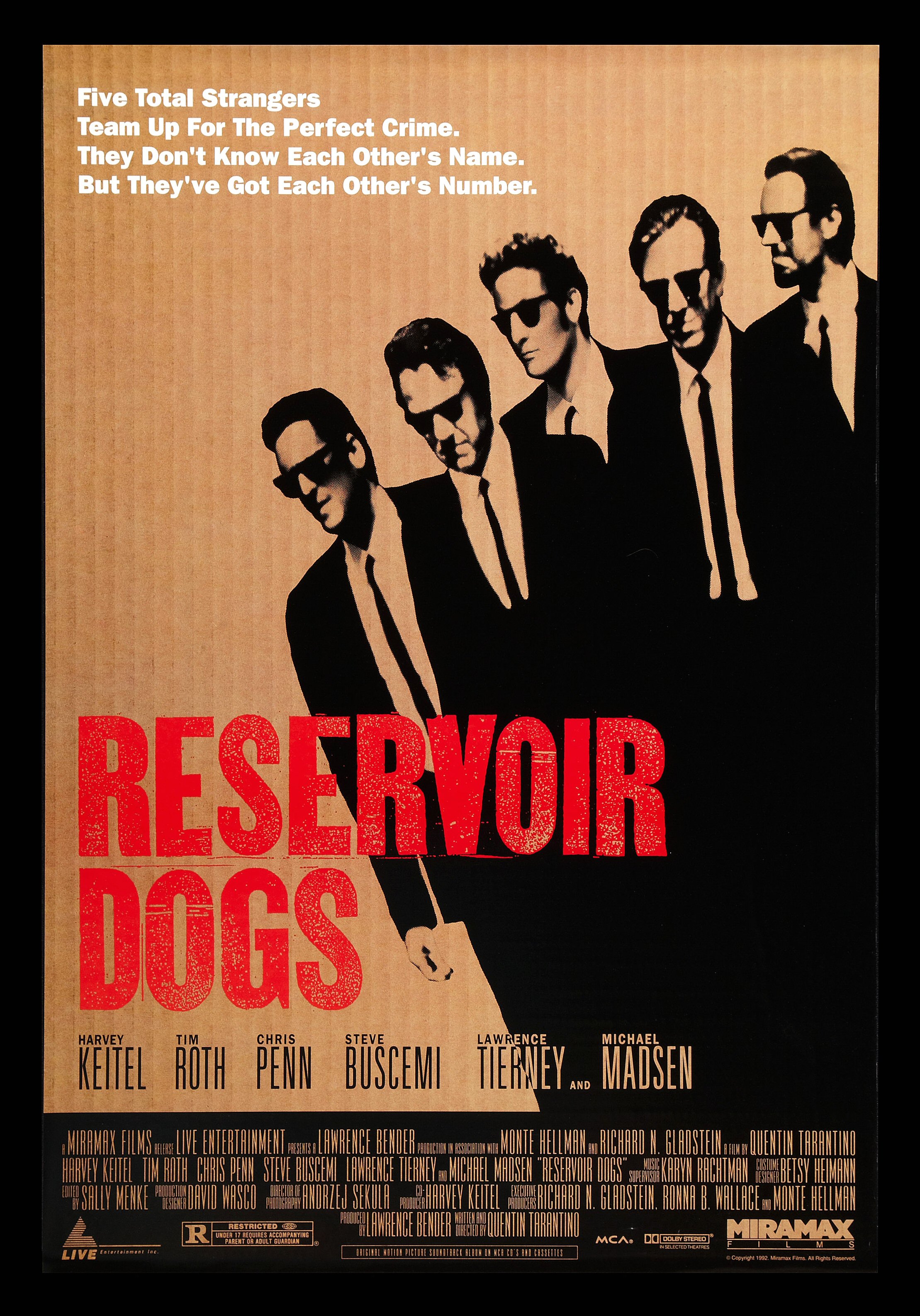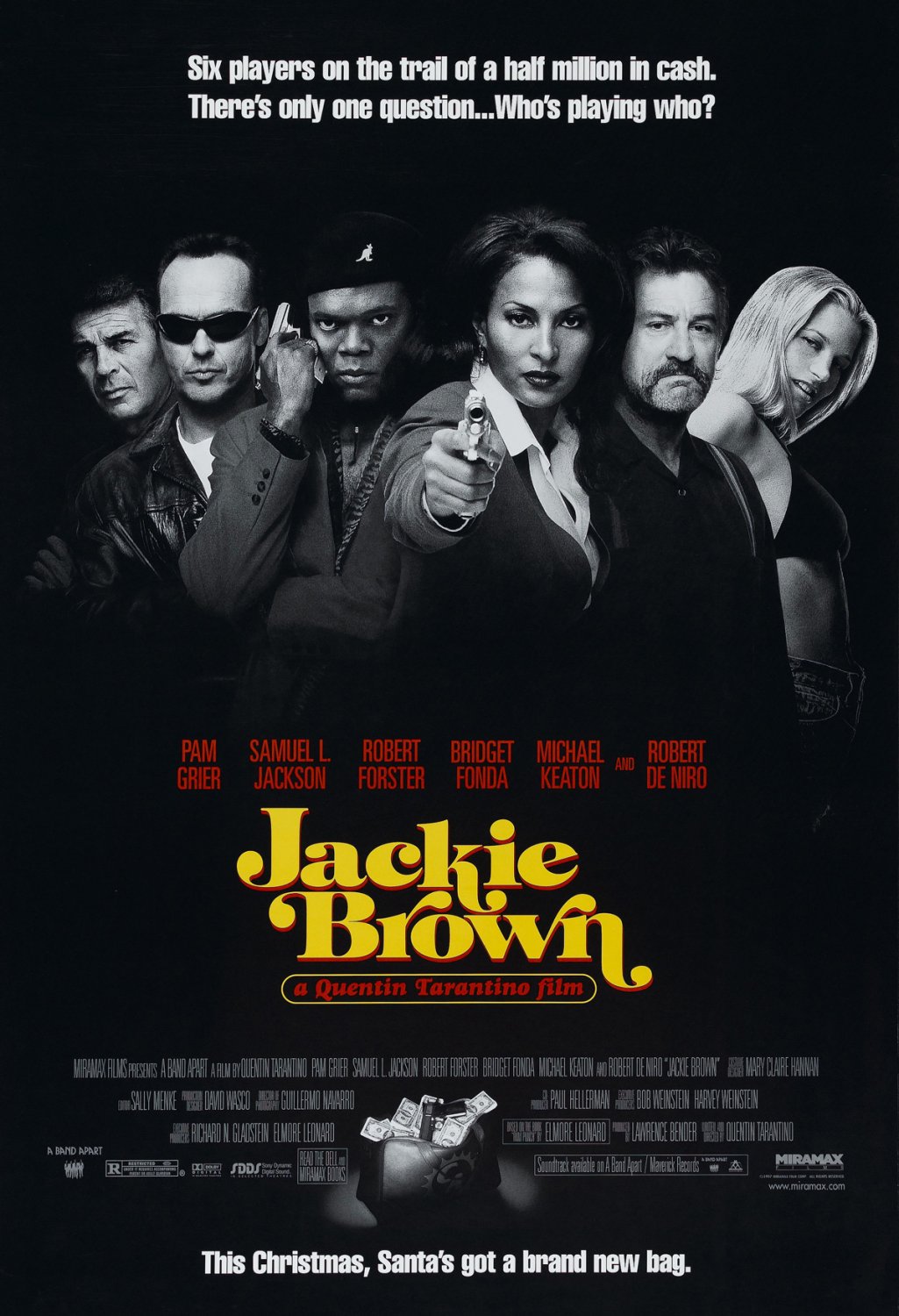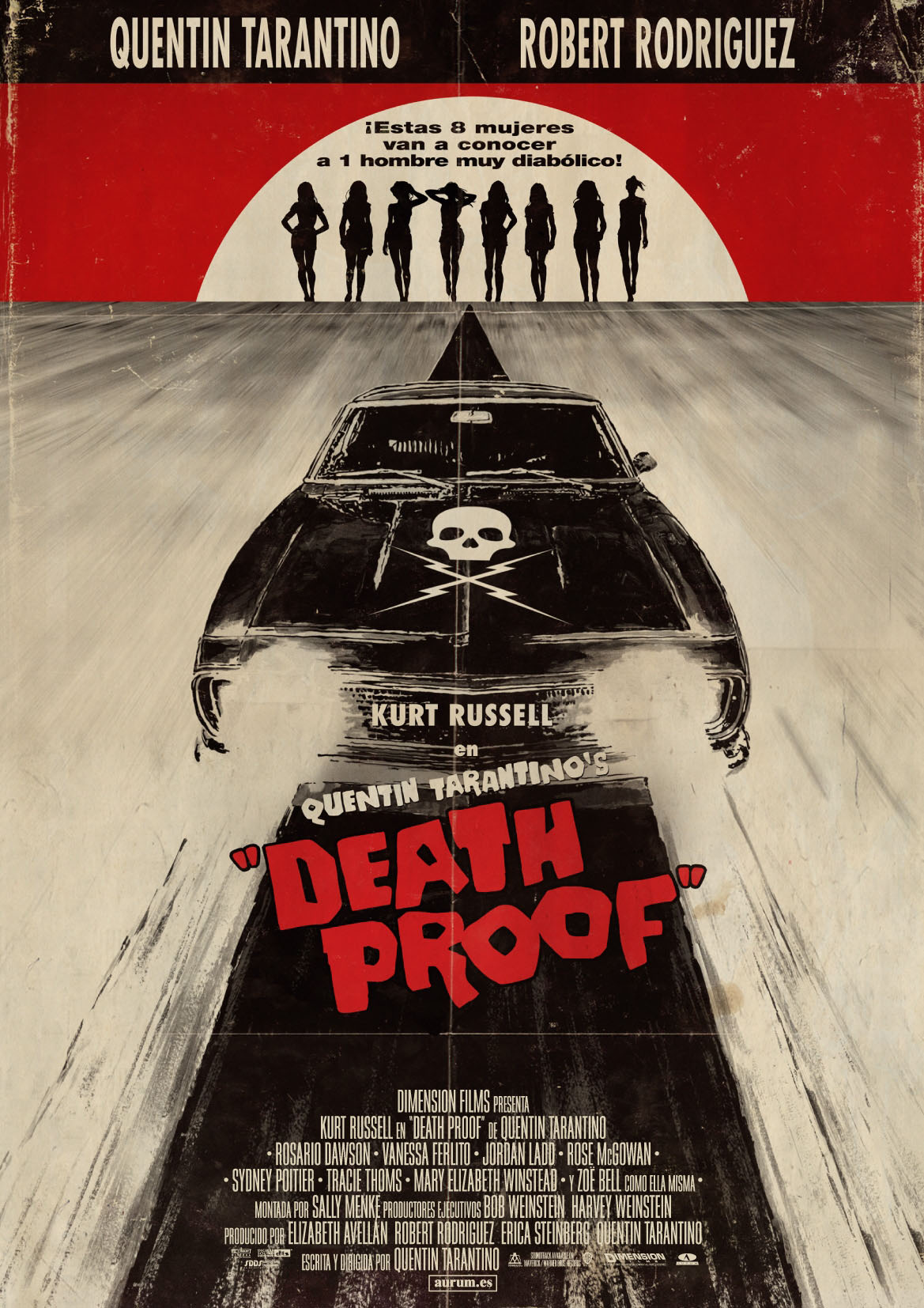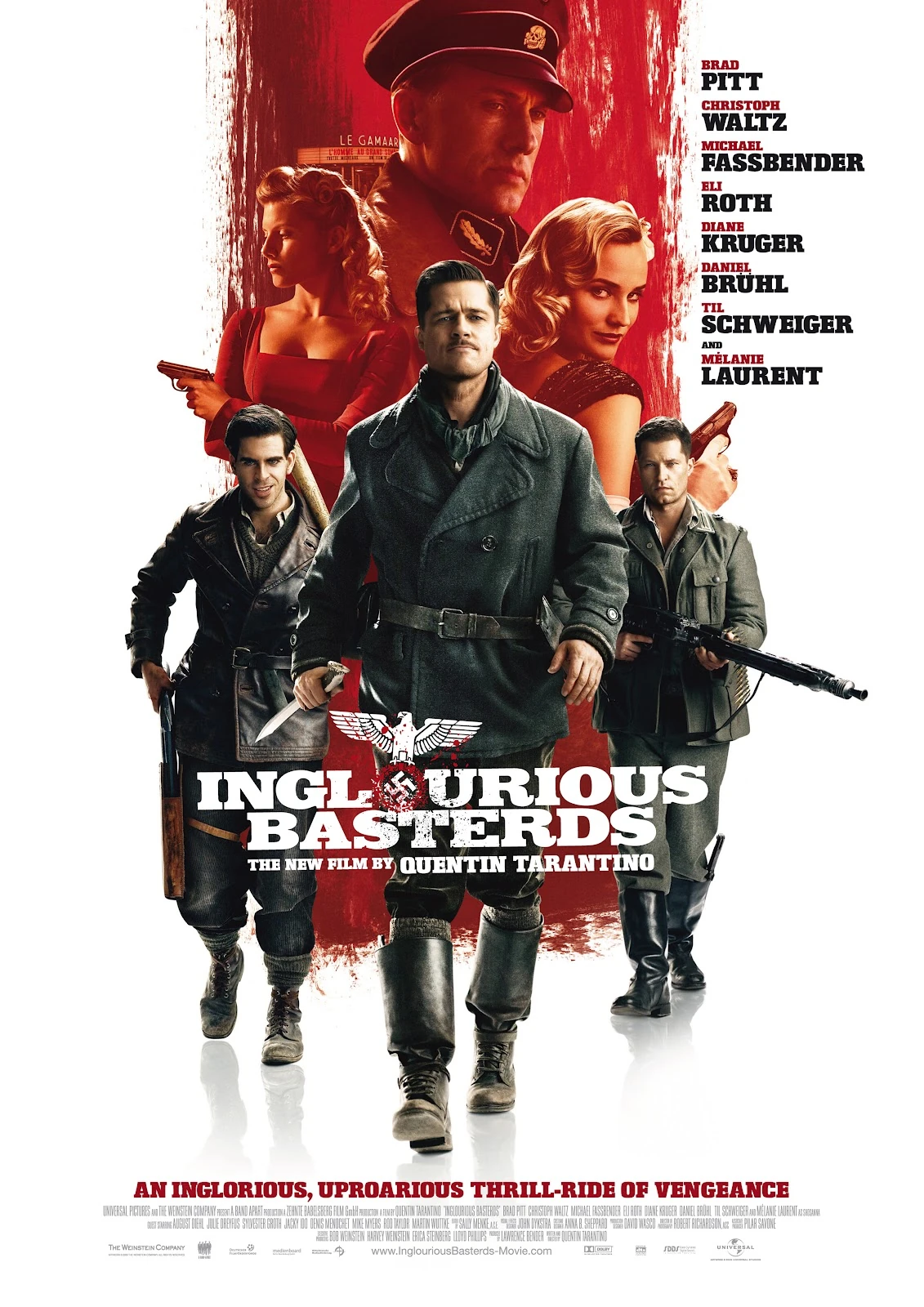(Happy New Year Everybody! Right now I am hard at work on my 'Top 12 Favorite Films of 2015' list but until those are finished, here's a brand new directorial retrospective focusing on film fan favorite, Quentin Tarantino, just in time for the release of his new film 'The Hateful Eight'. A quick review of that along with 'Joy' and 'The Big Short' will be posted in the next few days followed by the 'Top 12 Favorite Films of 2015' posts.)

It’s been a while since I did my last directorial
retrospective, heck over a whole year in fact. The last time I did this kind of
post was for the filmography of Christopher Nolan leading up to the release of
‘Interstellar’ back in November of last year. But today it’s time for a new one
with today’s subject being the film buff fan favorite, Quentin Tarantino. His
new film ‘The Hateful Eight’, which fittingly enough is his eighth feature film
(not counting his 2007 collaboration with Robert Rodriguez, ‘Grindhouse’, which
we will also be covering today… well, just Tarantino’s contribution to be
precise), will be hitting theaters soon and is certain to attract a lot of buzz
from the buffs who adore his films. Tarantino has also proven to be quite the
film buff himself with both his past experience as a video store clerk, his
adoration for non-digital film formats (‘Hateful Eight’ is being heavily
promoted as a 70mm release) and the many, many film references that have been
made in his films over the years. And while he’s certainly been a controversial
figure over the years as well due to things like his bold and brash off-screen
personality and his constant use of racial epithets in his films, film fans
can’t get enough of the stories, characters, and most importantly the dialogue
that he creates for his films. So today we’re celebrating the filmography of
one of film’s most electric directors from ‘Reservoir Dogs’ to ‘Django
Unchained’. These are the films of director Quentin Tarantino.
Also, on a side note,
today we’ll only be focusing on the films he directed and not the ones that he
only wrote like ‘True Romance’ and ‘Natural Born Killers’.
RESERVOIR DOGS (1992)

QT officially started his directorial career with ‘Reservoir
Dogs’, a story that was inspired by Stanley Kubrick’s 1956 noir flick ‘The
Killing’. And while it could be argued that this film is sometimes overshadowed
by its immediate successor, it’s still one hell of a start for Mr. Tarantino.
‘Reservoir Dogs’ is a heist film without the heist. In other words, the
majority of the film takes place after the planned heist of a diamond
wholesaler that majorly goes awry. The main conflict comes from the main characters
trying to figure out who was the one who ratted them out. All of this gives the
film quite a nice feeling of tension, which is even more impressive given the
fact that we don’t see the heist and most of the action takes place in a single
location. Of course this film introduced many of the trademarks that would
define Tarantino’s directorial style; the hard violence, the snappy profane and
pop culture-laced dialogue, and a non-linear method of storytelling. As noted,
the film skips over the heist and also pulls a few flashbacks at times that
expand upon the story. And the film of course has a tremendous cast highlighted
by Harvey Keitel, Tim Roth, Steve Buscemi, and Michael Madsen. And as a crucial
scene in the film proves, you don’t want to be stuck in a warehouse with a guy
like Mr. Blonde (Madsen) when the song ‘Stuck in the Middle with You’ is
playing on ‘K-Billy’s Super Sounds of the Seventies Weekend’. Simply put,
‘Reservoir Dogs’ is a low-budget masterpiece that started out Tarantino’s
career on the best note possible.
Rating: 5/5!
PULP FICTION (1994)

This is definitely one of those films where I don’t have to
go into too much detail about because it’s already been done by pretty much
everyone else. We all know how famous this film is; how it became one of the
most celebrated films of all-time, how it reignited the careers of people like
John Travolta and Bruce Willis and made Samuel L. Jackson a key player in
almost every subsequent Tarantino film, etc., etc. Any way you look at it, this
film is a true cinematic masterpiece. Tarantino’s dialogue is as terrific as
ever, the cast is superb from Samuel L. Jackson as the cool and philosophical
Jules Winfield to Uma Thurman as gangster Marsellus Wallace’s coke-addicted
wife Mia, and the film is full to the brim with memorable moments. There’s
Jules’ confrontation with a bunch of crooks where he recites ‘Ezekiel 25:17’
(technically not the actual scripture but who cares?), there’s the scene where
Vincent Vega (Travolta) and Mia dance the twist, the scene immediately after
that where Vincent has to revive Mia with adrenaline when she accidentally
snorts some heroin, and so on and so on. If I had to choose a favorite moment
from the film, I think it would have to be the segment titled ‘The Bonnie
Situation’. Somehow Tarantino managed to make a sequence in which one of the
main characters accidentally shoots someone in the head (“Oh man I shot Marvin
in the face.”) hilarious. I really don’t need to go on any further than that. I
don’t even think I ever came across someone who didn’t like this film.
Rating: 5/5!
JACKIE BROWN (1997)

‘Jackie Brown’ tends to be the one entry in Tarantino’s
filmography that’s the most forgotten. This adaptation of Elmore Leonard’s
novel ‘Rum Punch’ is Tarantino’s least successful film financially post-‘Pulp
Fiction’, which is a shame because it’s arguably just as good as his other
films. It seems like the reason for this was because the film was more
dialogue-driven than it was action-driven. But of course, it’s Tarantino so the
dialogue is as sharp as ever in this homage to the Blaxploitation films of the
1970’s, right down to the casting of Blaxploitation starlet Pam Grier in the
title role. Grier of course is excellent as the no-nonsense Jackie Brown, a
flight attendant who smuggles money across the border for a black-market dealer
but is sharp-witted and willing to double-cross anyone she comes across in
order to acquire a large amount of money. And of course like any Tarantino
film, ‘Jackie Brown’ features a wide array of memorable characters, from Samuel
L. Jackson as the aforementioned black-market dealer Ordell to Robert De Niro
as Louis, an associate of Ordell’s who is clearly in over his head to the point
where after he bungles a money exchange, he shoots Ordell’s roommate Melanie
(Bridget Fonda) in the parking lot of a mall when she starts to get on his
nerves. In conclusion, ‘Jackie Brown’ definitely stands as one of the most
underrated films of its time. It may not have been the Tarantino film that some
were expecting but it still deliver plenty of the things that make his films so
entertaining to watch.
Rating: 4/5
KILL BILL: VOL. 1 (2003) AND VOL. 2 (2004)
(Note: This following section will pair up both ‘Kill Bill’
films in order to respect its original form of being a four-hour film. However,
I will still be giving separate ratings/reviews for each of the two films.)

For Tarantino’s first major project in the 21st
century, he reunited with his ‘Pulp Fiction’ leading lady Uma Thurman for what
would ultimately become a two-part stylized ‘revenge flick’ inspired by martial
arts films like ‘Lady Snowblood’. Thurman stars as a woman named Beatrix Kiddo
AKA ‘The Bride’ AKA ‘Black Mamba’ AKA ‘Kiddo’ (she’s got a lot of nicknames)
who embarks on a personal vendetta against her former squad, the Deadly Viper
Assassination Squad led by her boss and former lover, the titular Bill (David
Carradine), when they try to kill her during her wedding. Originally the
project was slated to be one single 4-hour film and was originally presented
that way at the 2003 Cannes Film Festival. However, Tarantino and Harvey
Weinstein agreed to have the film split into two parts to maintain a more
respectable run-time for each film and so in 2003, ‘Kill Bill Vol. 1’ was
released, followed by its sequel, ‘Kill Bill Vol. 2’, in 2004. Both films
feature excellent action sequences, Tarantino’s trademark non-linear style of
storytelling, a beautiful visual style that pays homage to both the martial
arts and western genres (including an excellent anime sequence in ‘Vol. 1’ that
goes into the backstory of one of the Bride’s main targets), and one of the
best female action heroines of all-time in ‘The Bride’, with Uma Thurman giving
a career-best performance in the role.

The interesting part about these two films is that most of
the action takes place during ‘Vol. 1’ while ‘Vol. 2’ is more dialogue-driven.
I say it’s ‘interesting’ because a lot of recent ‘two-part’ films like ‘Harry
Potter and the Deathly Hallows’ and ‘The Hunger Games: Mockingjay’ do it the
other way around; the first film is set-up while the second film focuses on the
action. Anyway, ‘Vol. 1’ focuses on the Bride’s pursuit of Yakuza leader O-Ren
Ishii (Lucy Liu) and Vernita Green (Vivica A. Fox). Very much the ‘martial
arts’ half of the story, ‘Vol. 1’ features one of the best fight sequences in
film history as the Bride takes on the ‘Crazy 88s’, O-Ren, and the rest of her
associates at the House of Blue Leaves. As for ‘Vol. 2’, which feels more like
a western right down to the use of music from Ennio Morricone, it may not have
as much action as ‘Vol. 1’ but it still has some very memorable sequences,
including the Bride’s training with renowned martial artist Pai Mei, her fight
with fellow Pai Mei student Elle Driver (Daryl Hannah), and her climactic
mostly verbal confrontation with Bill, complete with a monologue about comic
book superheroes and their secret identities. And while ‘Vol. 2’ may have
benefitted from a few more action sequences, Tarantino’s direction is still
excellent and his dialogue is still superbly witty. As a whole, this is one
hell of a tale of revenge, showcasing the strong director-actor relationship
that is Quentin Tarantino and Uma Thurman. Will these two reunite for a ‘Vol.
3’, as a lot of people have been speculating? We’ll just have to wait and see.
Ratings: Part 1: 4.5/5, Part 2: 4/5 (As a whole: 4.5/5)
DEATH PROOF (2007)

‘Death Proof’ was Quentin Tarantino’s contribution to his
2007 collaboration with his friend Robert Rodriguez, ‘Grindhouse’, a double
feature paying tribute to the days of ‘grindhouses’, theaters that showed
B-movies and exploitation films. Rodriguez’s contribution, not counting his
‘fake’ trailer to what would eventually become 2010’s ‘Machete’, was the zombie
flick ‘Planet Terror’ but today we’ll solely be focusing on Tarantino’s car
chase flick ‘Death Proof’, in which a psychotic stunt man (Kurt Russell) stalks
and kills young women with his ‘death proof’ car, hence the title of the film.
This film is often regarded as Tarantino’s weakest film, even by Tarantino
himself. Ultimately I do have to agree with that. In fact, I can’t even say
that it’s ‘good’. Tarantino’s dialogue isn’t as strong this time around,
basically due to the fact that the film is mostly just scenes of dialogue and
exposition. It does get pretty dull at times. Though with that said, there are
still some good things in it. Kurt Russell is pretty darn good in the lead role
of the crazy ‘Stuntman Mike’ and the final car chase involving ‘Stuntman Mike’
and a group of stuntwomen, which involves Zoe Bell riding on the hood of a car,
is definitely one of the best car chases in recent years. But at the end of the
day, this is a Tarantino film for the biggest Tarantino fans only… and even
then you probably won’t like it.
Rating: 1.5/5
INGLOURIOUS BASTERDS (2009)

Tarantino changed up history quite a bit with his next film,
‘Inglourious Basterds’. Set in Germany during World War II, the film follows
the titular group known as ‘the Basterds’, a group of Jewish-American soldiers
who terrorize German soldiers by killing and scalping their victims and carving
swastikas into the foreheads of those they let live. But while Tarantino’s
alternate history war film is very much compelling just like his previous
films, it can be a bit flawed at times. The main reason for this is the
writing’s occasional veering into uneven territory. Despite being called
‘Inglourious Basterds’, the Basterds aren’t actually in the film that much. Instead,
the main focus of the film is Jewish survivor Shosanna Dreyfus, who plots
revenge against the German command after her family is killed by a German
patrol. Now I don’t mind too much that the film takes this route, nor do I mind
the occasional out-of-place reference that could understandably frustrate others.
However, as a result of this, shall we say, ‘bait and switch’, the story
doesn’t really have the same connective feel as something like ‘Pulp Fiction’
due to the Basterds not having ‘that much’ effect on the big finale, when
Shoshanna enacts her revenge against the Germans by burning down her theater,
leading to the deaths of Hitler and his associates.
Despite this, Tarantino’s direction is still excellent,
especially in the way he sets up sequences and creates tension through the
build-up towards the action. The pop cultural references aren’t really as
strong here due to the fact that this film takes place in the 40’s, meaning
that younger audiences probably will not get any of the references to the films
of that time, but the screenplay is still full of some memorable bits of
dialogue, mostly from Basterd leader Aldo Raine (“We ain’t in the
prisoner-taking business, we’re in the killing Nazis business!”). When the film
does get to the action, there are definitely some stand-out moments, including
the aforementioned finale in the burning theater. And despite one weak link in
the cast (Eli Roth, who, like Tarantino, definitely isn’t much of an actor),
the film is full of excellent performances from the likes of Brad Pitt as Aldo
Raine, Melanie Laurent as Shosanna, and a wide array of bit roles from stars
like Michael Fassbender, B.J. Novak, Diane Kruger, and Daniel Bruhl. And of
course we can’t forget about the film’s biggest scene-stealer, Christoph Waltz,
who rightfully won an Oscar for his turn as the despicable yet charming ‘Jew
Hunter’, Colonel Hans Landa. And ultimately, despite its shortcomings,
‘Inglorious Basterds’ is still another solid example of Tarantino’s talents as
a director.
Rating: 4/5
DJANGO UNCHAINED (2012)

Tarantino once again took a hammer to history with his
Southern revenge flick ‘Django Unchained’. Set in the Deep South two years
before the Civil War, the film follows slave turned free man turned bounty
hunter Django as he joins fellow bounty hunter Dr. King Schultz in hunting
outlaws while also looking to free his wife Broomhilda from her current slave
owner Calvin Candie. And boy is it one hell of a ride from start to finish. I
had previously done a review of this film back in December 2012 when I first
saw it in theaters with my friend Matt Goudreau. In fact, this was basically
the first Tarantino film that I’d ever watched. I had watched a bit of the
opening to ‘Inglourious Basterds’ a few years before but that was as far as I
got with the film at that time. As for ‘Django’, however, due to the fact that
I was also developing my ‘Best of the Year’ list at the same time, I only gave
it a short review alongside a short review of the other film Matt and I had
seen that day, ‘Les Miserables’. And even though I did list it at the #8 spot
on my ‘Best of the Year’ list, I don’t feel that I really gave it a proper
review there either because I basically just rehashed the same points I brought
up in my original ‘review’. So with that said, consider this to be a more
proper review of ‘Django Unchained’.
I completely understand if some are offended by certain
elements of the film, namely the frequent use of the n-word. Tarantino has
consistently used the word in his scripts but as for ‘Django Unchained’, the
film sets a record with 116 uses of the word. Seriously go on YouTube and
search for supercut videos of every use of it in the film. You’d swear you were
watching something out of a rap video. But aside from that, there has also been
a lot of people who weren’t too big on the film’s handling of the topic of
slavery. Whereas something like ’13 Years a Slave’ definitely captured the
extreme cruelty that came from this terrible practice, ‘Django Unchained’ takes
more of a ‘spaghetti western’ approach to it. Like I said, I understand if
certain people were bothered by this film. But as for me, this is my favorite
Tarantino film after the duo of ‘Reservoir Dogs’ and ‘Pulp Fiction’, and no
it’s not just because this was my first Tarantino film. Even with the route the
film takes in its portrayal of slavery and the constant use of the n-word, this
is perhaps Tarantino’s best screenplay in years. There aren’t as many pop
cultural references this time around but it does produce quite a lot of
memorable, and sometimes hilarious, moments, like when ‘Big Daddy’ (Don
Johnson) and his friends attack Django and Schultz but first get into an
argument over their bag masks (“I think we all think the bags was a nice idea.
But not to point any fingers… they could’ve been done better.”). And as for the
big shootout at Calvin Candie’s estate Candyland, it’s definitely one hell of a
shootout.
Christoph Waltz returns for his second straight Tarantino
film, this time in the ‘good guy’ role of Dr. King Schultz. And once again,
Waltz is phenomenal as the charismatic and badass bounty hunter. Waltz took
home a second Oscar for Best Supporting Actor for the role, but for many
people, the true star of the film is Leonardo DiCaprio in the role of Calvin
Candie. Simply put, Candie is one evil SOB. And yet somehow DiCaprio still manages
to bring on the charm when he’s not doing something awful. He even hurt his
hand for real during a scene where he smashes on a table and cuts himself on a
piece of glass. Sadly, DiCaprio got snubbed at the Oscars that year and even
though it’s nice that Waltz won for his role in the film, it definitely
would’ve been nice to see DiCaprio get some attention as well. These two
characters are so excellent that sometimes they do sort of overshadow Django,
the main character. However, Jamie Foxx is just as excellent in the role of the
smooth and badass Django. These three are also backed up by Kerry Washington as
Django’s wife Broomhilda and, of course, Samuel L. Jackson as Candie’s
extremely intimidating servant Stephen. And while the film is perhaps just a
bit overlong, serving as Tarantino’s longest film to date when not counting
‘Kill Bill’ when viewed as one film and the yet-to-be-released ‘Hateful Eight’
‘Django Unchained’ is one of the most entertaining films that Tarantino has
ever made.
Rating: 5/5!
No comments:
Post a Comment